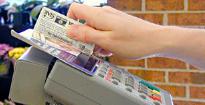Credit Card Offers Return at a Price
 The New York Times reports:
The New York Times reports:
Credit card offers are surging again after a three-year slowdown, as banks seek to revive a business that brought them huge profits before the financial crisis wrecked thecredit scores of so many Americans.
The rise is striking because it includes offers to riskier borrowers who were shunned as recently as six months ago. But this time, in contrast to the boom years, when banks “preapproved” seemingly everyone, lenders are choosing their prospects more carefully and setting stricter terms to guard against another wave of losses.
For consumers, the resurgence of card offers, however cautious, provides an opportunity to repair damaged credit and regain the convenience of paying with plastic. But there is a catch: the new cards have higher interest rates and annual fees.
Lenders are “tiptoeing their way back into the higher-risk pool of customers,” said John Ulzheimer, president of consumer education at SmartCredit.com.
In extending credit again to riskier borrowers, lenders are looking beyond standard credit scores, on the theory that some people who may seem to be equivalent credit risks on the surface may show differences in spending or other behavior — like registering on a job Web site — that suggest variations in their ability to keep up with payments.
Industry consultants, in their attempt to feed the demand for finer classifications of borrowers, have coined new labels to describe different borrowers with similar credit scores.
One is “strategic defaulters,” whose credit scores were damaged because they walked away from a home when its value dropped below what was owed on the mortgage. These borrowers made a bad bet on real estate but may otherwise be prudent risks because they make a good living.
Similarly, “first-time defaulters” once had a strong credit record but ran into financial trouble during the recession. Typically, these borrowers fell behind on some sort ofloan payment after losing a job, not from taking on too much debt.
By contrast, there are “sloppy payers,” who pay only some bills on time; “abusers,” who are defiant about paying; and “distressed borrowers,” who simply do not have the means to pay.
The goal is to weed out the latter groups to identify consumers whose credit scores are blemished but who still have the money to pay their bills.

